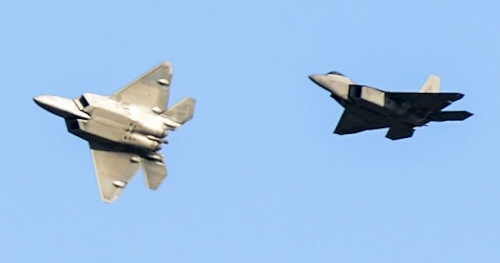Over the past few weeks, the United States has been hit very hard by the effects of Hurricane Michael, the so-called "4 category" storm which, although considerably weakened along its route through the Caribbean, has in any case discharged a huge force a once touched land on the coast of Florida. This time, however, the effects were not felt only on the infrastructure and the civilian population of the southern United States, whose real estate are under constant danger of suffering catastrophic devastation at the end of every American summer, but also on the same armed forces of the United States.
Hurricane Michael hit the Tyndall air base completely, devastating all the structures. It is not clear to what force the winds were traveling at the time of the disaster, but a meteorological station located on the coast registered the figure of 210 km / h before being in turn washed away. The trouble is that tropical storms have the ability to accelerate abruptly, as if they were waves, when they touched the ground, so the actual speed of impact on the base may have been much greater. This is evidenced, for example, by the fact that all F-15 radiati and exhibited static in various areas around the base have been literally lifted and hurled even several meters away from their original accommodations.
It is very difficult to estimate the damage caused to the Tyndall air base right now, but the aerial shots carried out by helicopters and drones and broadcast both on the network and through the main television channels suggest that a large part of the buildings were completely destroyed and even those with more solid walls have nevertheless been uncovered. The importance of what happened can be further emphasized by the fact that at Tyndall were stationed the 43esimo and the 95esimo hunting squadrons belonging to the 325esimo flock of the USAAF hunt equipped with a total of 55 aircraft from air supremacy Lockheed Martin F-22 Raptor.
 Officially entered into service in the 2005, the F-22 represents the epitome of the aircraft for air superiority combined with technology stealth to get the most fearsome 5a generation hunt currently in service in the world. Throughout the F-22 have been produced in 195 specimens (8 prototypes and 187 series aircraft) although, in the meantime, 5 (1 prototype and 4 series specimens) have been lost in various accidents, so the 55 basic specimens at Tyndall they represented about 30% of the entire combat and training line available on the USAF card. As Hurricane Michael approached, 33 cells capable of taking flight have been relocated to other bases, but other 22s in need of maintenance have remained in the finished hangars destroyed by the fury of the hurricane.
Officially entered into service in the 2005, the F-22 represents the epitome of the aircraft for air superiority combined with technology stealth to get the most fearsome 5a generation hunt currently in service in the world. Throughout the F-22 have been produced in 195 specimens (8 prototypes and 187 series aircraft) although, in the meantime, 5 (1 prototype and 4 series specimens) have been lost in various accidents, so the 55 basic specimens at Tyndall they represented about 30% of the entire combat and training line available on the USAF card. As Hurricane Michael approached, 33 cells capable of taking flight have been relocated to other bases, but other 22s in need of maintenance have remained in the finished hangars destroyed by the fury of the hurricane.
It is not clear at the moment how much damage suffered by Tyndall's F-22s or how many will eventually be declared "total losses" and canceled from the USAF flight logs, however this event is strikingly reminiscent of what struck the Self-Defense Forces Aerial of Japan during the 2011 Tohoku earthquake and tsunami, which also caused the Fukushima nuclear disaster. On that occasion, the tsunami wave also devastated Matsushima airbase leading to the loss or damage of 18 Mitsubishi F-2 fighters under the 21st fighter squadron stationed there (5 aircraft were declared "total losses" while the others 13 were repaired in the following years at a price of 490 million dollars).
Waiting to receive further developments and then waiting to assess whether the entire base Tyndall will finally be declared "total loss", it would be desirable that the United States and all Western countries, as well as Japan before them, begin to evaluate seriously the impact that environmental catastrophes such as Hurricane Michael can have on the infrastructural devices of their armed forces, to avoid that in future the air fleets made up of non-hyperbolic numbers of expensive devices are decimated by such catastrophic events when still parked in the hangars or on the runway and landing, and not from the enemy's action.
(photo: US Air Force)












